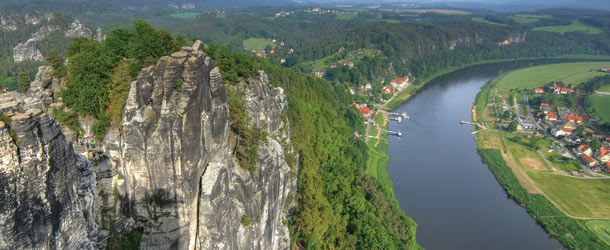In my last blog, I shared with you my love of touring the UK’s castles and how, once I’d seen all of those, I’d probably book myself on a river cruise in Europe, which as I explained, was a great way to go castle-spotting. My travels took me to the mighty Rhine, certainly the most renowned river when it comes to ancient fortifications but the truth is, there’s another river in Europe which offers more than its fair share of castles to enjoy.
The Elbe is one of Europe’s major rivers and though it rises in the Czech Republic, the majority of its 680 miles lie in Germany and while passing through the country on an Elbe river cruise, there are some great castles to explore which are usually part of your shore excursion options.
Luisium Castle, Dessau
If you’re exploring the Elbe by beginning your journey in Germany, one of the first notable structures you’ll be able to visit is Luisium Castle, nestled in the grounds of Worlitz Park. Once in the grounds, you may be forgiven for thinking that you’re back home, as the park is in fact Germany’s very first landscaped park and has been constructed in the style of an English country home. Grandly known as the Dessau-Worlitz Garden Realm, it’s a UNESCO World Heritage Site which boasts many notable structures, including a number of castles. Not a castle in the traditional sense, Neoclassical Luisium was built in 1774 in the style of a country home as a gift from Duke Leopold III to his wife and significantly, the Duke also died within its walls following a riding accident. If you find yourself with more time to spend in 55-square mile Worlitz Park, you can visit some of its other castles, such as Georgium, with its impressive art collection, the Rococo style Mosigkau and Groskhunnau, which is the headquarters of the park trust.
Hartenfels Castle, Torgau
Torgau is another popular stop on any Elbe river cruise and offers you the chance to explore its most notable landmark, Hartenfels Castle. The castle and indeed much of Torgau itself, is synonymous with Martin Luther and the history of the Protestant Reformation. Built in the Renaissance style, it’s a beautiful building to explore and there’s much history to uncover within its walls, as this is where Martin Luther posted his 95 theses. One thing not to miss is the Large Spiral Staircase in the castle courtyard. The work of celebrated architect Konrad Krebs, it supports itself without the help of a central pillar and you can of course climb it for that all-important picture looking downwards.
Dresden Castle, Dresden
Also known as the Royal Palace, the castle is one of this notable German city’s oldest buildings and is a must-see for all architectural buffs, employing a number of architectural styles including baroque and Neo-renaissance. Historically, it was the residence of the electors and then the kings of Saxony for 400 years, though today it houses an impressive museum complex. The most notable place to visit once in the complex is the Green Vault, where the Saxon monarchs’ crown jewels are held but the Dresden Armoury or Dresden Historical Museum is another must-see, as it contains one of the largest collections of ceremonial weapons and armour in the world.
By Simon Brotherton
Google



